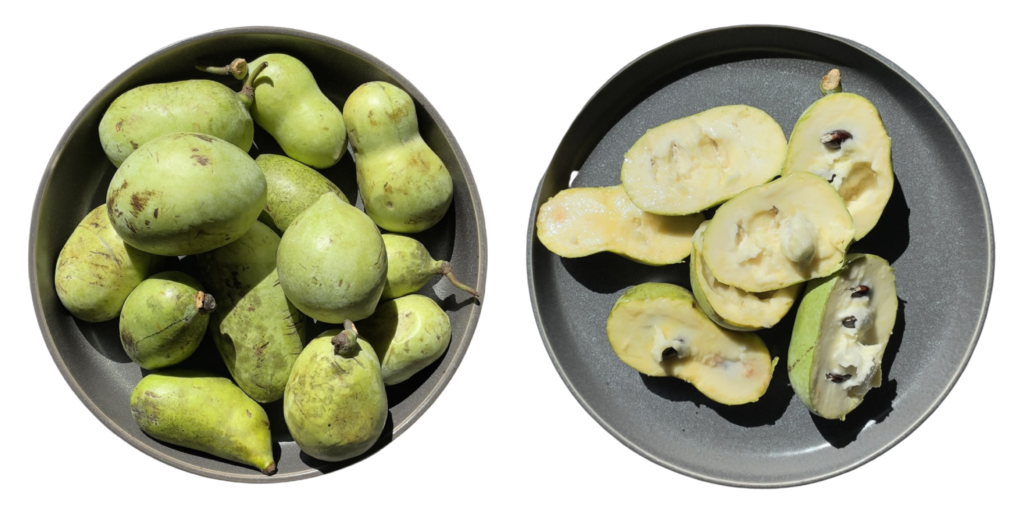CREATING THE PAWPAW COOKBOOK
Pawpaw season is upon us, and we interviewed Luisa Balieiro Guimaraes to learn all about this iconic native fruit! Luisa tested the recipes included in The Joy of Pawpaw, a new pawpaw cookbook produced by the North American Pawpaw Grower’s Association and the Ohio Pawpaw Festival. Pre-Order The Joy of Pawpaw now!
FIRST THINGS FIRST: WHAT ARE PAWPAWS?
“Pawpaw (Asimina triloba) is North America’s largest edible native tree fruit, but it comes from a tropical family (Annonacea). Therefore, it can be known as our “temperate tropical fruit.” This tree fruit can be found all throughout the state of Ohio, being considered the “Ohio’s Official Native Fruit”. Pawpaws also have a great nutritional value by having high amounts of vitamin C, magnesium, iron, copper, and manganese. Pawpaws are really cool because they are a tropical fruit that can grow outside of a tropical place, such as Ohio.”

HOW DID YOU GET INVOLVED WITH THE PAWPAW COOKBOOK?
“I initially became involved with pawpaw because I needed to pick a topic for my Honors’ project. I remember my advisor, Dr. Brannan, listing a few different topics that I could work on, in which one of them was about the fruit, pawpaw. At that moment I have never heard of that fruit before, but the name intrigued me and made me interested in finding out more about it. I later learned that some of the pawpaw’s “cousins” are found in Brazil such as graviola, and since I am originally from Brazil I felt a connection to the fruit. I also became very passionate about this project from the beginning because I knew that this cookbook could help with decreasing pawpaw waste by raising awareness of the fruit and introducing new and exciting ways to incorporate the fruit into different recipes.”
WHAT DID THE RECIPE TESTING PROCESS LOOK LIKE?
“The recipes that I tested come from the Pawpaw festival cookoff. Every year, the Ohio Pawpaw Festival holds the Pawpaw Cookoff. This special event allows competitors to prepare a food that incorporates pawpaw. A panel of food tasters awards first, second, and third place in different categories. The awarded recipes are recognized in the cookbook under the name of the recipe. For the recipes from the cookoff, I tested them out and made some changes that I found necessary (e.i. increase pawpaw, add a liquid). There are also some recipes, from the previous version, that after looking at them I decided to leave them in the updated version. After collecting the recipes, I processed the fruit by removing the skin and seeds and packing into Ziplock bags with the help of a food vacuum sealer. I then started to test the recipes, which I worked a lot during my Summer and then throughout a few other semesters. Because I was constantly tasting the food, there were only a few cases where I had to remake the recipe, those included cakes or breads.”
WHAT ARE SOME OF THE CHALLENGES OF COOKING WITH PAWPAWS?
“The pawpaw exhibits challenging post-harvest properties. Pawpaw is a climacteric fruit, meaning it visually ripens. This means that it must be used or processed immediately after harvest or major deteriorative changes will occur shortly thereafter, resulting in major waste of this delicious fruit. This factor limited me being able to work with fresh pawpaw. However, the fruit dethaw very quickly once immersed in water, making it easy to work. Another challenge is the fact that it is very hard to find this fruit when it is out of season, therefore, every year my advisor would make sure we had enough to process and be utilized in the recipes.”
WHAT ARE SOME OF THE JOYS OF COOKING WITH PAWPAWS?
“Pawpaw’s flavor is tropical, being described as a blend of banana and mango, among other flavors. I believe that the biggest joy of cooking with pawpaws is the fact that this fruit is very versatile. This fruit’s sweet taste and creamy texture allows it to be introduced into many different recipes, varying from sweets to savory. Since they are so versatile, the dietary substitutions that I recommended can be easily substituted. These recommendations consist of exchanging some of the ingredients to fit in a diet of someone who is vegan, vegetarian, gluten-free, and lactose intolerant.”

DO YOU HAVE ANY FAVORITE RECIPES FROM THE COOKBOOK?
“My favorite recipe is the pawpaw custard with the pawpaw caramel sauce. There are many reasons why this recipe is my favorite. First of all, I love custard ice cream and caramel, and both of them came out amazing. Having the pawpaw flavor in a custard worked perfectly, especially because there were small pieces present in it. This recipe is also my favorite because I decided to try making it during a cooking class. Since the testing of recipes happened during COVID-19, I had to rely on myself when trying them out. However, this recipe was one of the few that I was able to get people’s input. I remember that everyone really liked, and actually learned about pawpaws that day, which made me feel really happy in raising awareness for that fruit that is often forgotten.”
Luisa Balieiro Guimaraes is originally from Sao Paulo, Brazil, and she moved to Marietta, Ohio during her High School. She went to Ohio University (OU) for her undergraduate degree in Nutrition, and is now continuing her education at OU in the Combined Master of Science and Dietetic Internship Program. During her undergraduate she became involved with pawpaw through her Honors program, which led her to update the pawpaw cookbook by the North American Pawpaw Growers Association.
